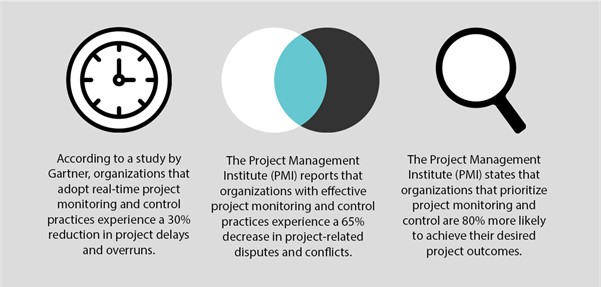
Have you ever faced challenges in tracking project progress? How did you address them? In the dynamic landscape of monitor and control project management, the key to success lies in the ability to monitor and control projects effectively. Project monitoring and control encompass a range of activities that involve tracking the progress of a project, identifying potential risks, and taking proactive measures to keep it on track. But what tools or techniques do you use for effective project monitoring and control?
Over the years, project control and monitoring have evolved from manual and time-consuming processes to sophisticated methods that leverage technology and data analytics. The objective of control and monitoring project management is to ensure the successful delivery of projects within the defined scope, timeline, and budget while maximizing stakeholder satisfaction."
“Continuous monitoring enables us to be proactive and responsive, allowing us to anticipate challenges and pivot as needed.”
- James Walker, CIO of Adaptive Projects, Inc.
Importance of Project Monitoring and Control
- Ensuring Timely Delivery: Timely project completion is crucial for meeting business objectives and staying competitive in the market. Effective monitor and control mechanisms ensure that the project stays on schedule, preventing delays and missed deadlines. Regular progress updates can help you identify potential bottlenecks and take corrective actions to keep the project on track.
- Managing Resources Efficiently: You should understand that the resources, including human capital, finances, and materials, are limited, and must be utilized optimally. monitoring and controls allows you to track resource allocation and usage, ensuring that resources are assigned to the right tasks and projects. By optimizing resource allocation, organizations can reduce waste, enhance productivity, and achieve better cost efficiency.
- Minimizing Risks: Every project involves uncertainties and potential risks that can impact its success. Effective monitoring and controlling projects include risk identification, assessment, and mitigation strategies. Proactive risk management helps project teams anticipate potential threats, develop contingency plans, and implement risk responses to minimize their impact on project objectives.
- Meeting Stakeholder Expectations: Engaging stakeholders throughout the project lifecycle is vital for project success. Regular and transparent communication keeps stakeholders informed about project progress, challenges, and achievements. Engaged stakeholders are more likely to provide support and resources, fostering a positive project environment and increasing the likelihood of successful project outcomes.
- Improving Decision-Making: Real-time data and insights obtained through monitoring and controlling in project management enable data-driven decision-making. Project managers can use performance metrics to evaluate project progress, identify trends, and make informed decisions about resource allocation, risk mitigation, and project priorities.
- Enhancing Quality: Quality is a crucial aspect of project success. Effective project controlling and monitoring ensures that your project deliverables meet quality standards and comply with stakeholder requirements. By monitoring quality metrics and conducting regular quality checks, your project teams can proactively address quality issues and deliver high-quality results.
- Adapting to Change: In today's rapidly changing business environment, projects often encounter unexpected changes and challenges. Effective monitoring and controlling processes provide project teams with the agility to adapt to changing circumstances. Project managers can use real-time data to assess the impact of changes, make necessary adjustments, and align the project with evolving business needs.
- Aligning with Business Goals: Successful projects align with the strategic objectives of the organization. Monitoring and controlling the project ensures that it remains focused on achieving business goals and align with the overall organizational strategy. Regular performance evaluations help project managers verify if the project is contributing to the organization's strategic objectives.
- Enhancing Team Collaboration: Collaboration among project team members is essential for seamless project execution. Project monitoring and controlling encourages open communication, fosters teamwork, and improves coordination among team members. By encouraging collaboration, you can create a supportive and cohesive team environment, leading to enhanced project outcomes.
- Boosting Project Success: Overall, once you monitor and control project work, it significantly contributes to project success. By implementing robust project controlling techniques, organizations increase their chances of delivering projects on time, within budget, and to the satisfaction of stakeholders.
"Transparent project monitoring fosters a culture of accountability and collaboration, where teams take ownership of their responsibilities and work towards a common goal."
- Samantha Lewis, CMO of Collaborative Dynamics

Effective Tips for Project Monitoring
- Establish Clear Objectives: Clearly define project objectives, scope, and key performance indicators (KPIs) from the outset. Well-defined objectives help project teams stay focused, align their efforts with the project's purpose, and measure progress accurately.
- Utilize Project Management Tools: Leverage project management software and tools to streamline monitoring and controlling project work. These tools offer real-time data, facilitate collaboration among team members, and provide visualizations to help project managers make data-driven decisions.
- Regularly Review Progress: Conduct regular project reviews at predefined intervals to assess progress, identify potential issues, and adjust the project plan as needed. Frequent reviews ensure that the project stays on track and meets its milestones.
- Encourage Transparent Communication: Create an open and transparent communication environment where team members feel comfortable sharing updates, challenges, and insights. Effective communication fosters collaboration, enables quick issue resolution, and keeps stakeholders informed.
- Set Milestones and Deadlines: Divide the project into manageable milestones with specific deadlines. Milestones provide clear checkpoints for progress evaluation and allow project managers to assess if the project is proceeding as planned.
- Involve Stakeholders: Engage stakeholders throughout the project lifecycle to gather their feedback, understand their expectations, and ensure alignment with project goals. Stakeholder involvement enhances project buy-in and increases the likelihood of project success.
- Monitor Resource Utilization: Keep a close eye on resource allocation and utilization to prevent resource overloading or underutilization. Optimizing resource allocation helps maintain project efficiency and reduces the risk of bottlenecks.
- Analyze Trends and Patterns: Regularly analyze data for monitoring and controlling project management helps identify trends, patterns, and potential areas for improvement. Analyzing data helps project managers make informed decisions and proactively address emerging challenges.
- Implement Corrective Actions: If any deviations or risks are identified during the process of monitoring and controlling project work, take corrective actions. Addressing issues early helps prevent them from escalating and minimizes their impact on project outcomes.
- Celebrate Achievements: Recognize and celebrate project achievements, milestones, and successes. Celebrating milestones boosts team morale, fosters a positive project culture, and motivates team members to stay committed to project success.
- Use Performance Metrics: Establish relevant performance metrics aligned with project objectives as parts of the project control techniques. Track these metrics regularly to assess progress and identify areas for improvement. Performance metrics provide valuable insights into project health and help project managers make data-driven decisions.
- Implement Change Management: Acknowledge that projects may face changes and uncertainties. Implement effective change management processes to assess the impact of changes, communicate them to the team, and ensure smooth project transitions. According to Sarah Miller, CIO of Transformational Ventures, "Embracing change management as an integral part of project management ensures that our teams are ready to embrace innovation and drive transformation."
- Establish Project Baselines: Set project baselines for scope, schedule, and budget. Baselines act as reference points to measure project performance and determine if the project is on track or needs adjustments when you are monitoring control.
- Involve the Entire Team: Involve all project team members in the monitoring and controlling project work. Encourage them to provide updates and share their observations. Collaboration among team members improves project communication and coordination.
- Continuous Improvement: Emphasize a culture of continuous improvement. Encourage the team to learn from past projects, capture lessons learned, and apply them to future projects to enhance project management practices.
In conclusion, effective project monitoring and control play a vital role in the success of any project. It involves the continuous assessment of project performance, identifying potential issues, and taking proactive measures to ensure project objectives are met. By implementing best practices and utilizing modern project management tools, organizations can optimize resource allocation, enhance team collaboration, and improve decision-making.
Regular project reviews, transparent communication, and stakeholder engagement foster a collaborative project environment and enable quick issue resolution. Moreover, analyzing trends and data empowers project leaders to make informed decisions and implement corrective actions promptly.
TrueProject plays a crucial role in helping firms with project monitoring and control by providing real-time visibility into project progress, facilitating effective communication, and enabling proactive decision-making. It facilitates the identification and tracking of project issues and risks. Project managers can log and monitor potential roadblocks, enabling them to take timely corrective actions and mitigate risks before they escalate. It allows firms to document changes, assess their impact, and implement approved changes while keeping track of the change history.
More information on TrueProject can be found at: TrueProjectInsight.com
 About the Author
About the Author
Brian Eckert is the Director of Engineering for TrueProject. Brian has 30+ years of experience in software development and process. He specializes in Requirements Analysis, Software Project Management, and SDLC.
Endnotes
- Brown, Lucy. “Understanding Project Monitoring and Control.” Invensis Learning, October 3, 2022. https://www.invensislearning.com/blog/understanding-project-monitoring-and-control/
- Frost, Shelley. “How to Monitor Project Progress.” Chron, July 1, 2018. https://work.chron.com/monitor-project-progress-3352.html
- ProjectPractical. “8 Tips to Effectively Monitor and Control Project Work”. https://www.projectpractical.com/8-tips-to-effectively-monitor-and-control-project-work/
- Soken-Huberty, Emmaline. “10 Reasons Why Monitoring and Evaluation is Important”. Tools4dev. https://tools4dev.org/blog/why-monitoring-and-evaluation-is-important/





